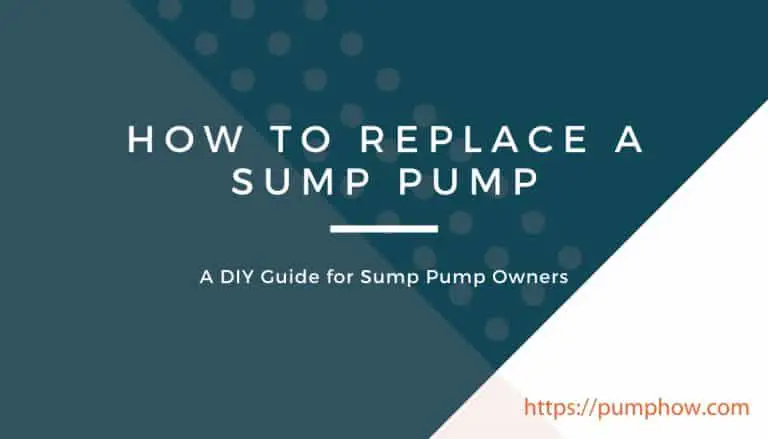Like any motorized appliance, a sump pump can’t be 100% quiet, but one particular pump can be quieter than another. Not all noises indicate a potential problem with the pump, but all of them can’t be ignored either.
So, it’s much of an obligation for homeowners to know about these strange/unusual noises and the right ways to get rid of them. This article explains the common instances when the noises occur and the quick fixes. Then, it discusses the specific causes and solutions so that you can take appropriate measures instead of acting upon some random findings.
Factors That Determine How Noisy a Sump Pump Can Be
The following factors are responsible for different noises, and they help you determine which level of noise may be heard.
- The pump’s design
- The location of the pump and the sump pit
- Materials of the sump pump
- The lubrication used for the parts
- The airtightness of the sump pit
- The age of the pump
5 Common Causes of Sump Pump Noise Problems
Apart from the design and materials of a sump pump, certain reasons contribute to a unit’s being unusually noisy or loud while operating.
These are just common causes which may not account for any particular kind of noise, but they’re surely considerable when you’re serious about an efficient and quiet unit running underneath the basement.
1. A Sump Pit with the Pump Coming Out
It’s the sump pit that houses a submersible pump to keep it quiet making it different from a pedestal pump. As it extends out of its housing (pit), there’s literally nothing to prevent it from spreading the noise outwardly.
So, you should find out the reason and work to keep it inside of the pit to ensure that it sits right where it should.
2. An Uncovered Sump Pit
Some homeowners don’t emphasize the use of any kind of lid for the pit. In fact, many of them don’t have to. But, it turns out, an uncovered pit is the reason behind mechanical noises as a pump starts working.
Sometimes, you may have heard strange gurgling noises (especially from water). The easiest way to get rid of it is to use an airtight lid to cover the sump pit.
3. A Vibrating Discharge Pipe
The discharge pipe vibrates and rattles against the lid or other fixtures just as the water starts flowing through it. To a lot of people, it’s quite simple, but you can still take care of it by using rubber grommets.
The liner lid and discharge pipe stand in gaps where the grommets have to be installed. Not only the grommets seal the lid, but also they can absorb the vibrations so that the discharge line can be kept still.
4. Poor Pump Design
Pumps with a plastic housing aren’t rare, but these pumps come with underlying issues like fragility, overheating, etc. In addition, plastic pumps are prone to noisy operations.
5. Defective Discharge Lines
Having a straight discharge line is important, but keeping an absolutely straight line may not always be possible. If water travels at variable angles down the discharge pipe, you might hear a lot of noise. So, a couple of angles measuring 45° can be used.
10 Types of Noise Problems and Solutions For Sump Pump
Understanding these common causes may be too confusing for many homeowners to figure out the actual cause. Well, let’s get straight to the specific noises, the reasons, and the ways out of them.
1. Hammering: A widely Misunderstood Sign
It’s perhaps the most common noise that homeowners hear, and there’s really nothing to worry because it doesn’t signal an actual problem. However, you might find it less than enjoyable when it gets a bit louder than usual.
Solution
Get a quiet check valve and have it installed to handle the issue. Today’s markets sell spring-loaded valves which help reduce the noise. By the way, don’t attempt to do it all if you aren’t confident. An expert’s help may be forthcoming.
2. Sump Pump Making Humming Noise
If your pump makes low humming noises, it’s okay. But. It’s time to take steps when the humming gets louder. It’s typically more concerning than hammering.
Solution
The vent hole might get clogged due to cold weather, or the check valve may have stuck. So, clean the hole first. You can fix the frozen pipes by using a space heater to warm or melt the ice. A damaged impeller, or the one with broken blades, or even a clogged filter may prevent the efficiency of the pump.
Replacing the blades or filter can be effective. Sometimes, unclogging the filter may prevent future jams and facilitate the operation.
3. Banging: how to stop sump pump banging noise
Sump pumps may make a loud banging sound which isn’t exactly what you’ll call ideal for it. The discharge piping system is the first thing you want to take care of.
Solution
Secure it by using 12-gauge wire. Fasten the pipes properly in place. If the exact point of the discharge pipe where the noise comes from can be identified, that specific area can be isolated by placing an extra bracket on that point, and thus, the issue can be solved. Make sure to use wood screws to attach the brackets firmly to floor joists.
4. Clanging
You may experience this type as the water flows out of the pipe. It’s common and usually occurs in the event of the pipes being not secured properly against their holders. The pipes then bang against their holders and create noise that eventually reverberates across the sump walls.
Solution
Using rubber grommets is a priority as mentioned above. To do this, you have to find out how far the pipes are apart from the holders. Choose the correct dimensions of the grommets accordingly and fit each of them into the available spaces to ensure that the pipe gets a snug fit.
It’s typically a part of the sump pump installation procedure. So, you may already have an understanding of the process.
Another good solution can be the alignment of discharge pipes at 45°/90°. You can get a leveling tool to find out the basement floor’s plane. Then, figure out the angles at which the pipes stretch from the pump. Ideally, they should be at 45°/90° to the basement plane.
Tighten all the pipe holders and then straighten the discharge pipe to keep the nonconforming sections straight to these angles.
5. Excess Vibration
As you’ve learned a little vibration isn’t really intimidating, but it’s much of a problem when the vibration occurs in excess. As the pipe comes into close contact with the basin, or it hits the nearby wall, or it contacts the floor directly, the noise might occur.
Solution
Use foam insulation to wrap the discharge pipe to the point where it comes into contact with the basin, floor, or wall. Using rubber grommets to line the pump cover can be a quick fix when rattling noises come from vibration.
Some discharge pipes may have a great number of joints, turns, and twists. In that case, you should replace or reroute the pipe to prevent future noises.
6. Sump Pump Grinding Noise
This noise isn’t uncommon for a grinder pump, but for a sump pump, you might want to put some attention to fix it. A faulty or jammed impeller can be the cause.
Solution
Instead of replacing this vital part, you can try cleaning it or clearing the jam. A quick inspection can be adopted prior to doing this.
7. Sump Pump Making Gurgling Noise
Once a pump cycle is completed and water goes back down the pump’s discharge pipe, you may get this noise coming. Standard pumps usually experience this problem the most.
Solution
We guess you already get the point of using a spring valve instead of a standard valve to reduce gurgling. A spring-loaded valve helps ensure an even flow of the water through the plumbing system. Adjusting the switch doesn’t let the water fully go out of the sump pit.
8. Slurping
Can you remember the noise that comes from one’s sucking liquid (water) through a pipe or straw? A dry pump creates similar noise except only a bit louder.
Solution
Adjust the pump settings in a way that it contains at least a few inches of liquid. Sometimes, faulty valves may cause this too. Replace them if necessary.
9. Thudding: Check Valve Sounds Like a Bouncing Ball
As a sump pump stops its operational cycle, you may hear a loud thud coming from the check valve attached to the pipes.
The valve works to keep the water flow back into the pump in check once the pressure falls. Part of valve’s work process causes it to shut close and produce a loud thudding noise. So, it’s not a surprise.
Solution
Using a silent valve may be a costly option to deal with such a regular thing, but it helps ensure a consistently quiet operation. Remember that it doesn’t replace anything but works separately. For a cheaper alternative, you may check the position of the valve and attach it at 45°. The process can be challenging for those who aren’t adept at it.
10. Loud Noise: sump pump sounds like garage door
Pumps that are older than 5-6 years may create loud noises. Again, pumps older than 2-3 years may also create the same. Maybe, lack of lubrication is the cause. Here’s a quick suggestion in this regard.
One Important Tip to Help You Choose the Right Pump!
Should you need a quietly running sump pump, you can focus on the design and material of a pump because a well-built pump saves you the hassles of maintenance or troubleshooting, especially when it comes to noise.
A cast-iron body is recommended. The top and bottom parts of some pumps use this particular material. Those units usually operate with less noise than those without the mentioned material. However, the ones with cast-iron throughout most of its body count for the most appropriate design.
In addition to this factor, you can consider self-lubricating pumps because these units can keep frictions as low as possible during the operation.
Final Words
Now that you’ve understood why a sump pump may run too loudly for you to ignore and how to deal with the different issues, you won’t worry about these strange noises anymore. But, we still appreciate your messages or queries. Feel free to let us know if you want help with anything relevant to the above situations!






